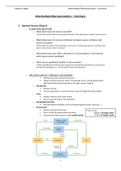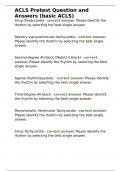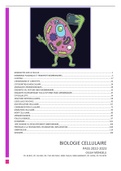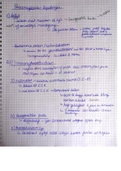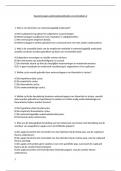Frédéric Kröger Intermediate Macroeconomics - Summary
Intermediate Macroeconomics – Summary
❖ National Income (Chap 3)
o 4 LONG-RUN QUESTIONS
o What determines the level of real GDP?
→ How much do the firms in the economy produce, what determines a nation’s total income?
o What determines the income distribution between owners of labour and
owners of capital?
→ Who gets the income from production, how much to compensate workers, and how much
goes to compensate owners of capital?
o What determines how GDP is allocated to C (consumption), I (investment),
and G (government spending)?
o What ensure equilibrium of flows in the economy?
→ What equilibrates the demand and supply for/of GaS (Goods and Services), what ensures
that desired spending on C, I and G equals the level of production?
o CIRCULAR FLOW OF $ THROUGH THE ECONOMY
▪ Reflects how real economies function
▪ Shows link btw economic actors: households, firms, and the government
AND how dollars flow among them through various markets
o Households
▪ Receive income
▪ Use it to pay taxes, to consume GaS, to save through financial markets
o Firms
▪ Receive revenue from sales of GaS
▪ Use it to pay for factors of production
o Households and firms
▪ Borrow financial markets to buy investment goods (house, factories, …)
o Government
▪ Receive revenue from taxes Public saving :
▪ Use it to pay for government purchases - Negative ➔ Budget deficit
▪ Any excess of tax revenue is called public saving - Positive ➔ Budget surplus
1
,Frédéric Kröger Intermediate Macroeconomics - Summary
o WHAT DETERMINES THE TOTAL PRODUCTION OF GaS?
▪ Economy’s output of GaS depends on
• Factors of production ➔ Qtt of input
• Production function ➔ Ability to turn inputs into outputs
o Factors of production
▪ Two most important are Capital
• Capital (K) ➔ Set of tools workers use
• Labour (L) ➔ Time people spend working
▪ We assume in this chapter that K and L are fixed and fully used
o Production function
▪ Function of amount of K and L
𝒀 = 𝑭(𝑲, 𝑳)
▪ Constant returns to scale ➔ If increase of certain percentage in all factors
of production, increase the output by same percentage
𝒛𝒀 = 𝑭(𝒛𝑲, 𝒛𝑳)
o Supply of Goods and Services
▪ Economy’s output ➔ Factors of production AND Production function
• Because K and L are assumed fixed → Output Y is also fixed
̅, 𝑳
𝒀 = 𝑭(𝑲 ̅)
o HOW IS NATIONAL INCOME DISTRIBUTED TO FACTORS OF PRODUCTION?
▪ Total output in economy = Total income
→ Factors of prod and prod function also determine national income
o Modern Theory of how income is divided among factors of prod is based on
▪ Classical (18th)
• Idea that price adjusts to balance supply and demand
▪ Neoclassical theory of distribution (19th)
• Demand for each factors of prod depends on its marginal productivity
o Factor Prices
➔ Amounts paid to each unit of factors of production (K and L)
▪ Determines distribution of national income
▪ Price received by each factor of prod depends on its supply and demand
• Assumption of fixed factors of prod
▪ Factor supply curve is vertical
▪ Supply is the same regardless of the price
▪ Equilibrium factor price (intersection)
• Demand for factors comes from firms that use K and L
→ Examine decisions firms make about how much factors to use?
o Decisions Facing a Competitive Firm
▪ Competitive firm has no influence on price (P), wage (W), or rent (R)
→ Sells at P, engage workers at W, and rent capital at rate R (market conditions)
▪ Goal of firm is to maximize profit
• Profit ➔ What owner keeps after paying for cost of production
𝑷𝒓𝒐𝒇𝒊𝒕 = 𝑹𝒆𝒗𝒆𝒏𝒖𝒆 − 𝑪𝒐𝒔𝒕
▪ Revenue
𝑹𝒆𝒗𝒆𝒏𝒖𝒆 = 𝑷𝒔𝒆𝒍𝒍𝒊𝒏𝒈 𝒑𝒓𝒊𝒄𝒆 × 𝒀𝒂𝒎𝒐𝒖𝒏𝒕 𝒐𝒇 𝒈𝒐𝒐𝒅𝒔 𝒇𝒊𝒓𝒎 𝒑𝒓𝒐𝒅𝒖𝒄𝒆𝒔
▪ Costs
▪ Labout costs
= 𝑾𝒘𝒂𝒈𝒆𝒔 × 𝑳𝒂𝒎𝒐𝒖𝒏𝒕 𝒐𝒇 𝒍𝒂𝒃𝒐𝒖𝒓
▪ Capital costs
= 𝑹𝒓𝒆𝒏𝒕𝒂𝒍 𝒑𝒓𝒊𝒄𝒆 × 𝑲𝒂𝒎𝒐𝒖𝒏𝒕 𝒐𝒇 𝒄𝒂𝒑𝒊𝒕𝒂𝒍
2
,Frédéric Kröger Intermediate Macroeconomics - Summary
• Profit = Revenue – Labour costs – Capital costs
𝑷𝒓𝒐𝒇𝒊𝒕 = 𝑷𝒀 − 𝑾𝑳 − 𝑹𝑲
▪ To see how profit depends on factors of prod, use prod function to
substitute for Y
𝑷𝒓𝒐𝒇𝒊𝒕 = 𝑷𝑭(𝑲, 𝑳) − 𝑾𝑳 − 𝑹𝑲
→ Shows that profit depends on product price P, factor prices W and R,
and factors qtt L and K
➔ Competitive firm takes prices as given and chooses amounts
of labor and capital that maximize profit
o Firm’s Demand for Factors
(What are those profit-maximizing quantities?)
▪ For Labour
• If extra revenue > cost from hiring, extra unit of labour increases profit
→ Manager continues to hire labour until extra revenue = cost
• Marginal Product of Labour (MPL) ➔ Extra amount of output firm gets
from one extra unit of labour (holding amount of capital fixed)
𝑴𝑷𝑳 = 𝑭(𝑲, 𝑳 + 𝟏) − 𝑭(𝑲, 𝑳)
▪ Diminishing marginal product
▪ If K is fixed, MPL decreases as amount of labour (L) increases
▪ MPL is slope of prod function
→ As amount of labour increases, prod function becomes flatter
• Extra revenue
▪ Extra unit of labour produces MPL units of output
𝑬𝒙𝒕𝒓𝒂 𝒓𝒆𝒗𝒆𝒏𝒖𝒆 = 𝑷 × 𝑴𝑷𝑳
• Extra unit of labour costs wage (W)
• Change in profit from hiring an additional unit of labour is
∆𝑷𝒓𝒐𝒇𝒊𝒕 = ∆𝑹𝒆𝒗𝒆𝒏𝒖𝒆 − ∆𝑪𝒐𝒔𝒕
∆𝑷𝒓𝒐𝒇𝒊𝒕 = (𝑷 × 𝑴𝑷𝑳) − 𝑾
• Competitive firm’s demand for labour is determined by
𝑾
𝑷 × 𝑴𝑷𝑳 = 𝑾 𝑴𝑷𝑳 =
𝑷
▪ Real wage (W/P) ➔ In term of units of output rather than in $
➔ To maximize profit, firm hires until MPL = Real wage
▪ For Capital
• Same way as for labour
• Marginal Product of Capital (MPK) ➔ Extra amount of output firm gets
grom one extra unit of capital (holding amount of labour fixed)
𝑴𝑷𝑲 = 𝑭(𝑲 + 𝟏, 𝑳) − 𝑭(𝑲, 𝑳)
▪ Diminishing marginal product
• Extra unit of capital costs machine’s rental price (R)
• Change in profit from renting an additional machine is
∆𝑷𝒓𝒐𝒇𝒊𝒕 = ∆𝑹𝒆𝒗𝒆𝒏𝒖𝒆 − ∆𝑪𝒐𝒔𝒕
∆𝑷𝒓𝒐𝒇𝒊𝒕 = (𝑷 × 𝑴𝑷𝑲) − 𝑹
• Competitive firm’s demand for capital is determined by
𝑹
𝑷 × 𝑴𝑷𝑲 = 𝑹 𝑴𝑷𝑲 =
𝑷
▪ Rental price of capital (R/P) ➔ In term of units of goods rather than in $
➔ To maximize profit firm rents until MPK = R/P
3
, Frédéric Kröger Intermediate Macroeconomics - Summary
o Division of National Income
• After analyzing how firm decides qtt of each factor to employ
→ Can explain how markets for factors of prod distribute total income
▪ If all firms in economy are competitive and profit maximizing, then each
factor of prod is paid its marginal contribution to the prod process
• Real wage paid to each worker = MPL
• Real rental price paid to each owner of capital = MPK
• Total real wages paid to labor → MPL x L
• Total real return paid to capital owners → MPK x K
• Economic profit of owners of the firm
➔ Income that remains after firms paid factors of prod
𝑬𝒄𝒐𝒏𝒐𝒎𝒊𝒄 𝒑𝒓𝒐𝒇𝒊𝒕 = 𝒀 − (𝑴𝑷𝑳 × 𝑳) − (𝑴𝑷𝑲 × 𝑲)
▪ Total income is divided among return to labor, return to capital, economic
profit 𝒀 = (𝑴𝑷𝑳 × 𝑳) + (𝑴𝑷𝑲 × 𝑲) + 𝑬𝒄𝒐𝒏𝒐𝒎𝒊𝒄 𝑷𝒓𝒐𝒇𝒊𝒕
How large is economic profit?
• If production function has property of constant returns to scale (as often
thought to be the case), economic profit must be zero
• Nothing is left after factors of prod are paid
• This conclusion comes from Euler’s theorem
▪ If prod function has constant returns to scale, then
𝑭(𝑲, 𝑳) = (𝑴𝑷𝑳 × 𝑳) + (𝑴𝑷𝑲 × 𝑲)
▪ So, constant returns to scale, profit maximization, and competition imply
that economic profit is zero
If economic profit = 0, how can we explain existence of “profit” in economy?
• Term profit as normally used is different from economic profit
• 3 types of agents (workers, owners of capital, owners of firms) and total
income divided (among wages, return to capital, economic profit)
BUT
Real world, most firms own rather than rent the capital they use
Because firm owners and capital owners are same people, economic profit
and return to capital are often lumped together
• If we call this alternative Accounting profit
𝑨𝒄𝒄𝒐𝒖𝒏𝒕𝒊𝒏𝒈 𝒑𝒓𝒐𝒇𝒊𝒕 = 𝑬𝒄𝒐𝒏𝒐𝒎𝒊𝒄 𝒑𝒓𝒐𝒇𝒊𝒕 + (𝑴𝑷𝑲 × 𝑲)
How income of the economy is distributed from firms to households
➔ Each factor of prod is paid its marginal product. If prod function has
constant returns to scale (Euler’s theorem), all output is used to
compensate the inputs. Total output is divided btw payments to capital
and payment to labour, depending on marginal productivities
o Cobb-Douglas Production Function (1927)
▪ Noticed that division of national income btw K and L had been roughly
constant over a long period of time
→ Total income of workers and of capital owners grew at same rate as
economy grew overtime
▪ For prod function to produce constant factor shares, if factors always earn
their marginal products, it need to have the property that:
• Parameter A is greater than 0 and measures productivity of available
technology
4
Intermediate Macroeconomics – Summary
❖ National Income (Chap 3)
o 4 LONG-RUN QUESTIONS
o What determines the level of real GDP?
→ How much do the firms in the economy produce, what determines a nation’s total income?
o What determines the income distribution between owners of labour and
owners of capital?
→ Who gets the income from production, how much to compensate workers, and how much
goes to compensate owners of capital?
o What determines how GDP is allocated to C (consumption), I (investment),
and G (government spending)?
o What ensure equilibrium of flows in the economy?
→ What equilibrates the demand and supply for/of GaS (Goods and Services), what ensures
that desired spending on C, I and G equals the level of production?
o CIRCULAR FLOW OF $ THROUGH THE ECONOMY
▪ Reflects how real economies function
▪ Shows link btw economic actors: households, firms, and the government
AND how dollars flow among them through various markets
o Households
▪ Receive income
▪ Use it to pay taxes, to consume GaS, to save through financial markets
o Firms
▪ Receive revenue from sales of GaS
▪ Use it to pay for factors of production
o Households and firms
▪ Borrow financial markets to buy investment goods (house, factories, …)
o Government
▪ Receive revenue from taxes Public saving :
▪ Use it to pay for government purchases - Negative ➔ Budget deficit
▪ Any excess of tax revenue is called public saving - Positive ➔ Budget surplus
1
,Frédéric Kröger Intermediate Macroeconomics - Summary
o WHAT DETERMINES THE TOTAL PRODUCTION OF GaS?
▪ Economy’s output of GaS depends on
• Factors of production ➔ Qtt of input
• Production function ➔ Ability to turn inputs into outputs
o Factors of production
▪ Two most important are Capital
• Capital (K) ➔ Set of tools workers use
• Labour (L) ➔ Time people spend working
▪ We assume in this chapter that K and L are fixed and fully used
o Production function
▪ Function of amount of K and L
𝒀 = 𝑭(𝑲, 𝑳)
▪ Constant returns to scale ➔ If increase of certain percentage in all factors
of production, increase the output by same percentage
𝒛𝒀 = 𝑭(𝒛𝑲, 𝒛𝑳)
o Supply of Goods and Services
▪ Economy’s output ➔ Factors of production AND Production function
• Because K and L are assumed fixed → Output Y is also fixed
̅, 𝑳
𝒀 = 𝑭(𝑲 ̅)
o HOW IS NATIONAL INCOME DISTRIBUTED TO FACTORS OF PRODUCTION?
▪ Total output in economy = Total income
→ Factors of prod and prod function also determine national income
o Modern Theory of how income is divided among factors of prod is based on
▪ Classical (18th)
• Idea that price adjusts to balance supply and demand
▪ Neoclassical theory of distribution (19th)
• Demand for each factors of prod depends on its marginal productivity
o Factor Prices
➔ Amounts paid to each unit of factors of production (K and L)
▪ Determines distribution of national income
▪ Price received by each factor of prod depends on its supply and demand
• Assumption of fixed factors of prod
▪ Factor supply curve is vertical
▪ Supply is the same regardless of the price
▪ Equilibrium factor price (intersection)
• Demand for factors comes from firms that use K and L
→ Examine decisions firms make about how much factors to use?
o Decisions Facing a Competitive Firm
▪ Competitive firm has no influence on price (P), wage (W), or rent (R)
→ Sells at P, engage workers at W, and rent capital at rate R (market conditions)
▪ Goal of firm is to maximize profit
• Profit ➔ What owner keeps after paying for cost of production
𝑷𝒓𝒐𝒇𝒊𝒕 = 𝑹𝒆𝒗𝒆𝒏𝒖𝒆 − 𝑪𝒐𝒔𝒕
▪ Revenue
𝑹𝒆𝒗𝒆𝒏𝒖𝒆 = 𝑷𝒔𝒆𝒍𝒍𝒊𝒏𝒈 𝒑𝒓𝒊𝒄𝒆 × 𝒀𝒂𝒎𝒐𝒖𝒏𝒕 𝒐𝒇 𝒈𝒐𝒐𝒅𝒔 𝒇𝒊𝒓𝒎 𝒑𝒓𝒐𝒅𝒖𝒄𝒆𝒔
▪ Costs
▪ Labout costs
= 𝑾𝒘𝒂𝒈𝒆𝒔 × 𝑳𝒂𝒎𝒐𝒖𝒏𝒕 𝒐𝒇 𝒍𝒂𝒃𝒐𝒖𝒓
▪ Capital costs
= 𝑹𝒓𝒆𝒏𝒕𝒂𝒍 𝒑𝒓𝒊𝒄𝒆 × 𝑲𝒂𝒎𝒐𝒖𝒏𝒕 𝒐𝒇 𝒄𝒂𝒑𝒊𝒕𝒂𝒍
2
,Frédéric Kröger Intermediate Macroeconomics - Summary
• Profit = Revenue – Labour costs – Capital costs
𝑷𝒓𝒐𝒇𝒊𝒕 = 𝑷𝒀 − 𝑾𝑳 − 𝑹𝑲
▪ To see how profit depends on factors of prod, use prod function to
substitute for Y
𝑷𝒓𝒐𝒇𝒊𝒕 = 𝑷𝑭(𝑲, 𝑳) − 𝑾𝑳 − 𝑹𝑲
→ Shows that profit depends on product price P, factor prices W and R,
and factors qtt L and K
➔ Competitive firm takes prices as given and chooses amounts
of labor and capital that maximize profit
o Firm’s Demand for Factors
(What are those profit-maximizing quantities?)
▪ For Labour
• If extra revenue > cost from hiring, extra unit of labour increases profit
→ Manager continues to hire labour until extra revenue = cost
• Marginal Product of Labour (MPL) ➔ Extra amount of output firm gets
from one extra unit of labour (holding amount of capital fixed)
𝑴𝑷𝑳 = 𝑭(𝑲, 𝑳 + 𝟏) − 𝑭(𝑲, 𝑳)
▪ Diminishing marginal product
▪ If K is fixed, MPL decreases as amount of labour (L) increases
▪ MPL is slope of prod function
→ As amount of labour increases, prod function becomes flatter
• Extra revenue
▪ Extra unit of labour produces MPL units of output
𝑬𝒙𝒕𝒓𝒂 𝒓𝒆𝒗𝒆𝒏𝒖𝒆 = 𝑷 × 𝑴𝑷𝑳
• Extra unit of labour costs wage (W)
• Change in profit from hiring an additional unit of labour is
∆𝑷𝒓𝒐𝒇𝒊𝒕 = ∆𝑹𝒆𝒗𝒆𝒏𝒖𝒆 − ∆𝑪𝒐𝒔𝒕
∆𝑷𝒓𝒐𝒇𝒊𝒕 = (𝑷 × 𝑴𝑷𝑳) − 𝑾
• Competitive firm’s demand for labour is determined by
𝑾
𝑷 × 𝑴𝑷𝑳 = 𝑾 𝑴𝑷𝑳 =
𝑷
▪ Real wage (W/P) ➔ In term of units of output rather than in $
➔ To maximize profit, firm hires until MPL = Real wage
▪ For Capital
• Same way as for labour
• Marginal Product of Capital (MPK) ➔ Extra amount of output firm gets
grom one extra unit of capital (holding amount of labour fixed)
𝑴𝑷𝑲 = 𝑭(𝑲 + 𝟏, 𝑳) − 𝑭(𝑲, 𝑳)
▪ Diminishing marginal product
• Extra unit of capital costs machine’s rental price (R)
• Change in profit from renting an additional machine is
∆𝑷𝒓𝒐𝒇𝒊𝒕 = ∆𝑹𝒆𝒗𝒆𝒏𝒖𝒆 − ∆𝑪𝒐𝒔𝒕
∆𝑷𝒓𝒐𝒇𝒊𝒕 = (𝑷 × 𝑴𝑷𝑲) − 𝑹
• Competitive firm’s demand for capital is determined by
𝑹
𝑷 × 𝑴𝑷𝑲 = 𝑹 𝑴𝑷𝑲 =
𝑷
▪ Rental price of capital (R/P) ➔ In term of units of goods rather than in $
➔ To maximize profit firm rents until MPK = R/P
3
, Frédéric Kröger Intermediate Macroeconomics - Summary
o Division of National Income
• After analyzing how firm decides qtt of each factor to employ
→ Can explain how markets for factors of prod distribute total income
▪ If all firms in economy are competitive and profit maximizing, then each
factor of prod is paid its marginal contribution to the prod process
• Real wage paid to each worker = MPL
• Real rental price paid to each owner of capital = MPK
• Total real wages paid to labor → MPL x L
• Total real return paid to capital owners → MPK x K
• Economic profit of owners of the firm
➔ Income that remains after firms paid factors of prod
𝑬𝒄𝒐𝒏𝒐𝒎𝒊𝒄 𝒑𝒓𝒐𝒇𝒊𝒕 = 𝒀 − (𝑴𝑷𝑳 × 𝑳) − (𝑴𝑷𝑲 × 𝑲)
▪ Total income is divided among return to labor, return to capital, economic
profit 𝒀 = (𝑴𝑷𝑳 × 𝑳) + (𝑴𝑷𝑲 × 𝑲) + 𝑬𝒄𝒐𝒏𝒐𝒎𝒊𝒄 𝑷𝒓𝒐𝒇𝒊𝒕
How large is economic profit?
• If production function has property of constant returns to scale (as often
thought to be the case), economic profit must be zero
• Nothing is left after factors of prod are paid
• This conclusion comes from Euler’s theorem
▪ If prod function has constant returns to scale, then
𝑭(𝑲, 𝑳) = (𝑴𝑷𝑳 × 𝑳) + (𝑴𝑷𝑲 × 𝑲)
▪ So, constant returns to scale, profit maximization, and competition imply
that economic profit is zero
If economic profit = 0, how can we explain existence of “profit” in economy?
• Term profit as normally used is different from economic profit
• 3 types of agents (workers, owners of capital, owners of firms) and total
income divided (among wages, return to capital, economic profit)
BUT
Real world, most firms own rather than rent the capital they use
Because firm owners and capital owners are same people, economic profit
and return to capital are often lumped together
• If we call this alternative Accounting profit
𝑨𝒄𝒄𝒐𝒖𝒏𝒕𝒊𝒏𝒈 𝒑𝒓𝒐𝒇𝒊𝒕 = 𝑬𝒄𝒐𝒏𝒐𝒎𝒊𝒄 𝒑𝒓𝒐𝒇𝒊𝒕 + (𝑴𝑷𝑲 × 𝑲)
How income of the economy is distributed from firms to households
➔ Each factor of prod is paid its marginal product. If prod function has
constant returns to scale (Euler’s theorem), all output is used to
compensate the inputs. Total output is divided btw payments to capital
and payment to labour, depending on marginal productivities
o Cobb-Douglas Production Function (1927)
▪ Noticed that division of national income btw K and L had been roughly
constant over a long period of time
→ Total income of workers and of capital owners grew at same rate as
economy grew overtime
▪ For prod function to produce constant factor shares, if factors always earn
their marginal products, it need to have the property that:
• Parameter A is greater than 0 and measures productivity of available
technology
4


